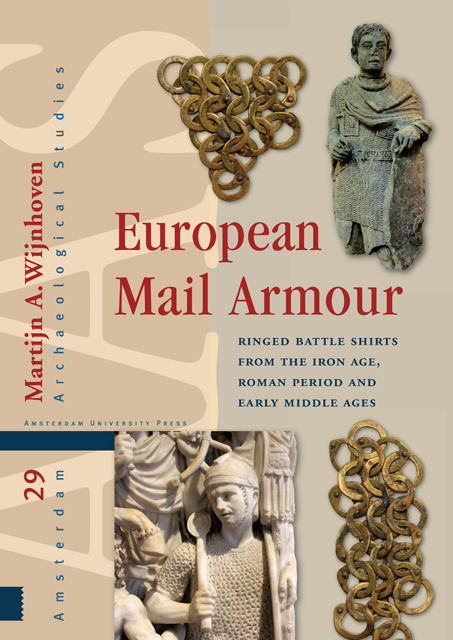Book contents
- Frontmatter
- Contents
- Acknowledgements
- Dedication
- 1 Introduction
- 2 The origins of mail armour
- 3 Distribution and archaeological context
- 4 The iconography of early mail armour
- 5 The naming of mail armour
- 6 Decoration in mail garments
- 7 Padded garments
- 8 The craft of making mail rings
- 9 Weaving patterns
- 10 The construction of mail garments
- 11 Ring characteristics
- 12 Final considerations
- Bibliography
- Database
- Appendix 1 Catalogue of mail armour
- Appendix 2 Catalogue of hybrid armour
- Appendix 3 Catalogue of isolated finds of fasteners and fixtures
- Appendix 4 Finds excluded from the database
2 - The origins of mail armour
Published online by Cambridge University Press: 24 November 2022
- Frontmatter
- Contents
- Acknowledgements
- Dedication
- 1 Introduction
- 2 The origins of mail armour
- 3 Distribution and archaeological context
- 4 The iconography of early mail armour
- 5 The naming of mail armour
- 6 Decoration in mail garments
- 7 Padded garments
- 8 The craft of making mail rings
- 9 Weaving patterns
- 10 The construction of mail garments
- 11 Ring characteristics
- 12 Final considerations
- Bibliography
- Database
- Appendix 1 Catalogue of mail armour
- Appendix 2 Catalogue of hybrid armour
- Appendix 3 Catalogue of isolated finds of fasteners and fixtures
- Appendix 4 Finds excluded from the database
Summary
‘Whoever may have been the inventors of this armour, the probability seems to be that it came into use gradually: from its costliness and rarity, leaders only could at first obtain it; that, as handicraft improved, and the efficiency of the defence became acknowledged, its adoption was extended, and its costliness diminished.’
John Hewitt
SUGGESTED PRECURSORS
The history of technology teaches us that very few artefact types appear without any antecedents or influences. Likewise, mail armour probably did not come out of nowhere. Although little research has been done on the possible predecessors of mail, there are a few tentative suggestions involving artefacts with metal rings that form some kind of wearable mesh.
One of the earliest suggested ancestors of mail comes from Brno-Židenice, Czech Republic, where a single grave of the Horákov Culture, dated to Hallstatt C (800-650 BC), contained nearly 15,000 small bronze rings. These rings, however, did not interconnect but were woven onto a textile, with the threads of the warp and weft passing through them (fig. 2.1). The amount of rings suggests that the original garment must have been large and heavy, which probably ignited the idea that it constituted the remains of some sort of body armour. This interpretation is nevertheless unlikely. As the rings were not interconnected, the structural strength of the piece would have relied entirely on the textile threads, which in turn were not tightly woven due to the insertion of the metal rings. The resulting fabric would have been easily shredded by any edged weapon, making it unsuitable for the rigours of battle. This makes it more likely that it was worn for personal adornment. The find is not unique and similar textiles with inserted bronze rings have been found in Maiersch (Austria) dating to Hallstatt C and in a high status female grave at Waldalgesheim (Germany) dated around 325 BC.
Another category of mail-like artefacts is meshes of interconnected bronze rings with no textile support. The Spanish cemeteries of Almaluez and Clares, dated to the turn of the 5th century BC, have yielded ten fragments of these meshes, formed by larger flat-laying rings that each connect to four smaller rings placed at an angle (fig. 2.2).
- Type
- Chapter
- Information
- European Mail ArmourRinged Battle Shirts from the Iron Age, Roman Period and Early Middle Ages, pp. 13 - 34Publisher: Amsterdam University PressPrint publication year: 2021



